 Image search results - "yo" Image search results - "yo" |

Dai-hiwatari Festival, Mt. TakaoMore pictures here
|
|

My video of 2023 Koenji Awa Odori. 第64回高円寺阿波おどり
|
|

My video of 2018 Koenji Awa Odori 第62回高円寺阿波おどり
|
|

My video of 2017 Koenji Awa Odori (56 troupes) 第61回高円寺阿波おどり
|
|

My video of 2016 Koenji Awa Odori (56 troupes) 第60回高円寺阿波おどり 56連の総集編
|
|

My video of Koenji Awa Odori 2015 第59回高円寺阿波おどり 40連の総集編
|
|

My video of Koenji Awa Odori 2013 Part 1/3 第57回 東京高円寺阿波おどり 総集編
|
|

My video of Koenji Awa Odori 2013 Part 2/3 第57回 東京高円寺阿波おどり 総集編
|
|

My video of Koenji Awa Odori 2013 Part 3/3 第57回 東京高円寺阿波おどり 総集編
|
|

My video of Koenji Awa Odori 2011 Part 1/2 高円寺阿波おどり
|
|

My video of Koenji Awa Odori 2011 Part 2/2 高円寺阿波おどり
|
|

My video of Koenji Awa Odori 2009 Part 1/3 - Kokesaku 苔作
|
|

My video of Koenji Awa Odori 2009 Part 2/3 - Kikusui-ren 菊水会菊水連
|
|

My video of Koenji Awa Odori 2009 Part 3/3 - Asuka-ren 飛鳥連
|
|
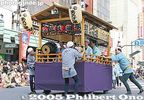
Sadly, the Tokyo Jidai Matsuri no longer held. It used to be held annually on Nov. 3 (Culture Day) in Asakusa, Tokyo.the Tokyo Jidai Matsuri (Festival of Historical Periods) is a parade tracing the history of Tokyo with over 1,600 people dressed in the respective period's costume. This is the lead float playing music. It took about an hour for the parade to reach Kaminarimon Gate.
Lead Float: Edo festival music played by children. Kodomo Edo-bayashi yatai
先導 子供江戸囃子屋台
|
|
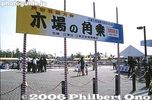
Kiba Park with Kiba Kakunori sign. Traditional folk performances are held on the same day as Koto Ward's Citizen's Festival in mid-Oct. So the park is quite crowded.
|
|

Haneda to Tokushima
|
|
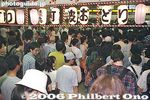
Crowd at JR Koenji Station on Awa Odori night.The Koenji Awa Odori is basically a parade of dancers. Many groups of dancers from various parts of Japan participate in the parade that follows the main shopping streets near Koenji Station on the Japan Railways Chuo Line in Tokyo.
|
|

April 8, 2006 at Ushigome-Tansu Kumin Hall in Kagurazaka, TokyoStarting at 4 pm, this was the third and last show of the day and all 400 seats were sold out.
The performance had two parts separated by a 20-min. intermission. Each part had several different dances.
|
|

Before 8 am: Women do a warm-up lap.It wasn't exactly warm, but they had wet suits. Odaiba's water is not exactly crystal-clear clean either.
|
|

Established in 1617, Tsukiji Hongwanji temple is the Tokyo headquarters of the Nishi Hongwanji Jodo Shinshu sect. The present temple, based on Indian architecture, was built in the 1930s.The temple is the only one in Japan which is under the direct control of the sect. Its head priest is the Monshu Abbot himself. April 8 is observed as Buddha's birthday, called Hana Matsuri ("Flower Festival) in Japan.
|
|

Yasukuni Shrine is Japan's most prominent shrine for the war dead. Near Kudanshita Station on the Tozai Subway Line. This is the first giant torii
|
|

One of Kyoto's Big Three Festivals held on May 15. The Aoi Matsuri's colorful procession of over 500 people in Heian-Period costumes start off at the Kyoto Gosho Imperial Palace and head for the Shimogamo and Kamigamo Shrines. Kyoto Gosho Imperial Palace 京都御所: The first ox carriage waits for the procession to start. The ox carriage is called a gissha. 牛車
|
|

Torokko train at Arashiyama for Hozu Gorge
|
|

Kameyama Castle is now headquarters to a religion called Omoto-kyo which acquired the castle property in 1919. Only stone walls and moats remain.Statue of shachihoko.
|
|

PR poster for the Kamogawa Odori geisha dance held during May 1-24 in Pontocho.
|
|

Held on Dec. 2-3 by Chichibu Shrine, Chichibu Yomatsuri is one of Japan's Big Three Hikiyama Float Festivals. Ornate floats are pulled along the city's main streets until they reach a large plaza at night where they are lit with lanterns. Fireworks then serve as the climax. Photo: Seibu Chichibu Station
|
|

Kakegawa Castle as seen from the train
|
|

Yasukuni Shrine during the Mitama Matsuri before dark.
|
|

Road to Himeji Castle. From Himeji Station, the main road leads to the castle which can be seen in the distance.
|
|

Akashi StationOn the JR Sanyo Line.
|
|

Nijo-jo castle was built on the order of Tokugawa Ieyasu to serve as the Kyoto residence for the Tokugawa shoguns. Although it does not have a castle tower, Nijo-jo Castle is Japan's best preserved and most magnificent castle palace.Seinan-sumi (Southwest corner) Turret is the first castle building you see when you walk from the station. Important Cultural Property 西南隅櫓
|
|

Akashi Castle seen from the train platform of Akashi Station.
|
|

Nose Myokenzan Betsuin at a street corner. In Feb., priests at this small temple splash cold water on themselves for 30 min. Near Honjo-Azumabashi Station on the Toei Asakusa Line or JR Kinshicho Station on the Sobu Line.
|
|

Tokyo Dome on March 3, 2006, the first day of the WBC's Asian Round.
|
|

Hanegi Park is near Odakyu Umegaoka Station ("Umegaoka" means plum hill). 小田急梅ヶ丘駅
|
|

To Tokyo Big Sight
|
|

Sign and entrance to Tokyo Big Sight
|
|

Yoshino Baigo was a valley and hillside covered with ume plum trees. It boasted a wide variety of different plum blossoms. During full bloom as you can see here, the scenery was spectacular. One of the largest plum groves in Japan.Platform of Hinata-Wada Station with welcome banner 日向和田駅. Banner says, "Yokoso, Ume no Sato Yoshino Baigo." Yokoso means "welcome," and Ume no Sato means "plum town."
To get to Hinata-Wada, you have to change trains at Ome Station on the JR Chuo Line.
|
|
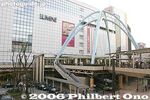
JR Tachikawa Station
|
|

Cherry tree forest near the Nishi-guchi (west) gate.
|
|

The outdoor architectural museum is within Koganei Park in Koganei, Tokyo. This is the Visitors Center.
|
|

Ryogoku Kokugikan sumo arena as seen from Ryogoku Station
|
|

The Kokugikan as seen from JR Ryogoku Station platform.
|
|

PR poster designed by Tetsuo OshiroPoster for the race.
京都大学ボート部OBの尾城徹雄様に作成したポスター。大学内や大津市石山商店街などで張り出された。
|
|
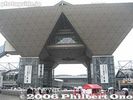
On June 6, 2004, the Athens Olympic Torch Relay came through Tokyo as it has been doing at all cities in the world which had held a Summer Olympics. Starting point: Tokyo Big SightI chased the flame for Athens at several points in Tokyo.
|
|
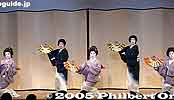
"Hana no Kai" Dance by Kagurazaka geishaThe "Hana no Kai" geisha dance is held annually by geisha in Kagurazaka, one of Tokyo's major geisha districts. "Hana" means livley or gaudy. And "Kai" can mean gathering or party.
They held two shows on the same day. This was the second show starting at 3 pm on April 16, 2005. It lasted till about 4:45 pm.
|
|
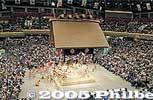
More people than the real tournamentAbout 8,000 people took time out from their Golden Week holidays to see this official sumo practice of all sumo stables.
|
|
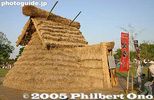
Festival's focal pointThis grass hut is at the center of the festival site which is within the Sakitama Tumuli Park. It will be burned later in the evening for the festival's climax.
|
|
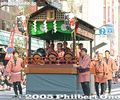
This page is a complete English guide to all the groups that appear in the parade. The parade assembles behind Sensoji Temple and starts at 1:30 pm from Nitenmon gate. The procession then goes down Umamichi-dori street, passes by Matsuya Department Store.先導 子供江戸囃子屋台
|
|
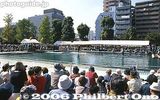
Huge crowd at Kakunori pond in Kiba Park.
|
|

Hi Philbert! Welcome aboard!
|
|

Each dance troupe starts with a lantern bearer showing the name of the troupe.The dance is quite simple. While bobbing up and down, the dancer holds her hands above the head and shakes the fingers. This hand gesture indicates that the person has gone crazy. It is therefore nicknamed the "fool's dance." The dance is held on the last weekend in August.
|
|

Part 1 - Edo Scenes (江戸風情): 1. Fuji Murasaki (Purple Wisteria) 藤むらさきDancers: 小奴、千佳、由良子、舞子
|
|

Women at the starting line for triathlon
|
|

Tsukiji Hongwanji temple gate with wisteria crest.The emblem is a wisteria flower and symbol of the Jodo Shinshu sect.
|
|

Path to shrine
|
|
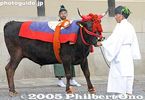
The bull was mooing all the time and was very restless.Do bulls moo or do they snort? This was making a loud noise.
|
|

Pontocho Kaburenjo theater, venue for Kamogawa Odori.
|
|
|

Kameyama Castle was built by Akechi Mitsuhide in the 16th century as his base for his conquered Tanba region.
|
|

In front of Seibu Chichibu Station
|
|
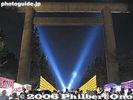
Yasukuni Shrine's main torii during Mitama Matsuri
|
|

Yotsuashi-mon GateMain gate to enter the castle grounds. A reconstruction.
四足門
|
|

Road to Himeji Castle. Otemae Boulevard (Symbol Road). 大手前通り
|
|
|

Akashi Castle seen from the train platform of Akashi Station.
|
|

Shrine hall
|
|

Tokyo Dome
|
|

Entrance to Hanegi Park's plum grove
|
|

Entrance to Tokyo Big Sight
|
|

Tokyo Big Sight hallway
|
|

Closest train station is Hinata-Wada Station. To get to Hinata-Wada, you have to change trains at Ome Station on the JR Chuo Line. 日向和田駅Sadly, spring 2014 was the last time we could see these trees. The plum trees were infected by the plum pox virus and the city cut down all the trees in 2014 to wipe it out. These photos were taken in 2006 when the plums were still fully glorious. Good news is that they have been replanting since 2016.
|
|
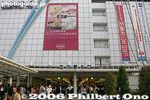
JR Tachikawa Station entrance
|
|

Koganei Park sakura
|
|

Going to visitors center
|
|

Crowd outside the Kokugikan await their favorite wrestlers.
|
|
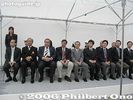
Dignitaries at the torch relay starting ceremony.
|
|

"Blue Ocean Waves" (青海波)They performed four numbers. This first one was called "Blue Ocean Waves" performed by five geisha.
|
|
|

Offerings
|
|

From Matsuya Department Store, the procession turns right into Kaminarimon-dori street which passes in front of the famous, giant red lantern called Kaminarimon Gate. Lead float with Edo festival music played by children. 先導 子供江戸囃子屋台
|
|
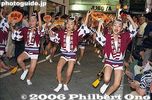
The troupe can consist of children (as young as age 2 or 3), women, and men.The Awa Odori originated 400 years ago in Tokushima Prefecture (in Shikoku) where it is one of Japan's most famous festivals. Although it is not as large as the one in Tokushima, the Koenji Awa Odori in Tokyo has become a major summer festival in Tokyo.
|
|
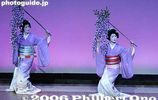
1. Fuji Murasaki (Purple Wisteria)
|
|

Temple gate and flag
|
|
|

Norijiri horseman leads the procession. 乗尻The procession, called Roto-no-Gi (路頭の儀), is actually one of three rites performed during the festival.
|
|
|

Statue of shachihoko roof ornament
|
|

Pontocho is a narrow alley and known as a geisha district.
|
|

Main street crowd
|
|

Promenade to the shrine
|
|
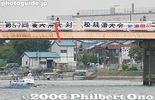
Karahashi Bridge as the starting point for alumni races
|
|

Steps to the castle tower
|
|

Uchibori Inner Moat
|
|

Minami-mon (South) Gate 南門
|
|

Barrels of cold water in front of shrine
|
|

Front entrance to Tokyo Dome. Japan plays its first WBC game and the opponent is China.
|
|

The plum trees are on a small hill.
|
|

Photo Imaging Expo 2006 sign
|
|

Corridor to anime fair
|
|

Although still small, the replanted plum trees have been flowering. and the groves have reopened to the public. Yoshino Baigo poster. Yoshino Baigo is a small town in Ome city near Hinata-Wada Station.
|
|
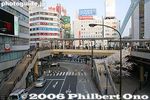
JR Tachikawa Station walkways
|
|

Huge trees shower you with cherry blossoms.
|
|

Visitors Center entrance courtyard
|
|

Crowd enters the Kokugikan for Musashimaru's retirement ceremony on Oct. 2, 2004.
|
|
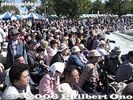
It starts at 11 am, so if you want a good view, go there early.
|
|

Starting line
|
|

Nagashima Kazushige substitues for his father, baseball hero Nagashima Shigeo, who was hospitalized.
|
|

Notice that the kimono design shows waves.
|
|

Yokozuna Deliberation Council membersIn the middle is Kitanoumi.
|
|

Festival siteIt is a circular site with people sitting along the perimeter.
|
|

Lead float with Edo festival music played by children. The names of the children playing are written on the red lanterns hanging above. Kodomo Edo-bayashi yatai 先導 子供江戸囃子屋台
|
|

The Koenji Awa Odori has become a major summer festival in Tokyo. It had a humble beginning in 1957 when it was originally called the Koenji Baka Odori. "Baka" means fool.
|
|

Kiba Sqaure Log Rolling is performed by the Kiba Kakunori Hozon-kai or Preservation Society. 木場角乗保存会
|
|

1. Fuji Murasaki (Purple Wisteria)
|
|

8:10 am: And they're off, taking about 30 min. to swim 1.5 km.
|
|

Play room for kids on Hanamatsuri
|
|

Statue of Omura Masujiro (1824-1869) 大村益次郎, founder of Japan's modern army. Also pushed for the establishment of Yasukuni Shrine.
|
|

10:30 am: Starting point at Kyoto Gosho Imperial Palace 京都御所 出発The procession is ready to depart.
|
|

Dance program for 2005.
|
|
|
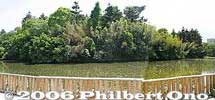
Castle compound and moat
|
|

Floats parked along the main drag.
|
|
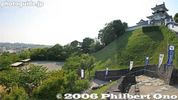
Castle tower
|
|

Castle moat
|
|

Spotlights create a silhouette of the statue of Omura Masujiro (1824-1869) 大村益次郎, founder of Japan's modern army.
|
|

Castle moat
|
|

Tonan-sumi (Southeast corner) Turret, Important Cultural Property 東南隅櫓
|
|

Barrels of cold water
|
|

Chinese team is introduced.
|
|

Hanegi Park has plum blossoms in mid-Feb. to early Mar. It has about 700 plum trees and also sports facilities and public library.
|
|

Hallway
|
|

PR poster
|
|

Road to Yoshino Baigo. Almost the entire town is lined with plum trees.
|
|
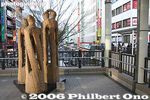
Walkway sculpture
|
|
|
|
|

Passing out programs
|
|

An Olympic torch attendant stands by to hand over the torch. In his right hand, he holds a small lantern housing a little flame in case the main torch is snuffed out.
|
|
|
|
|

SpectatorsThese people are sitting in the best area to view the festival.
|
|
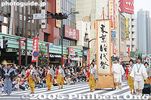
Tokyo Jidai Matsuri Banner and Tekomai geisha. From top to bottom, the banner reads, "Tokyo Jidai Matsuri." It marks the official and real start of the festival parade. The first Tokyo Jidai Matsuri was held in 1989. 東京時代祭本旗The first Tokyo Jidai Matsuri was held in 1989. Slight changes in the festival have been made since. Instead of two oiran courtesans, there is only one now. And at the end of the parade, the Asakusa Revue of showgirls used to be the anchor. But they are now gone.
東京時代祭本旗、手古舞
|
|
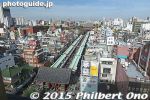
Bird's eye view of Asakusa with Kaminarimon Gate (big red lantern) and Nakamise arcade.
|
|

Kiba used to be where wood and lumber were stored and produced. 相乗り
|
|

1. Fuji Murasaki (Purple Wisteria)
|
|
|

Hanamatsuri altar
|
|
|

The procession basically consists of two columns: The Hon-retsu which includes the procession's highest-ranking official called Chokushi. It consists of men. The second and longer column is the Saio-dai-retsu consisting of women.
|
|

Barrels of sake next to the theater.
|
|

Hozu River
|
|

Castle moat
|
|

Ornate float is pulled along the streets toward Chichibu Shrine.
|
|

A bon dance around the base of the statue.
|
|

Kyoto Univ. in dark blue T-shirts
|
|

Stairs to Kakegawa Castle tower
|
|

Path to Otemon Gate, the main gate to the castle. 大手門
|
|

Entrance to Akashi Park
|
|

Tonan-sumi (Southeast corner) Turret 東南隅櫓
|
|

The congregation gather on the steps and beat fan-shaped drums.
|
|

Japan's National Anthem is played.
|
|
|

To PIE 2006 held in late March.
|
|

The crowds
|
|

Tamagawa River as seen from the bridge.
|
|
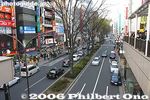
Street
|
|

One trademark of the dancers is the crescent-shaped straw hats.
|
|
|
|

Musashimaru at the entrance
|
|

The Greek ambassador to Japan gives the torch to Kazushige.
|
|

Rear view
|
|

Sumo elders in the front row
|
|

EntertainmentAn outdoor stage provides a variety of entertainment during the day.
|
|
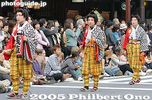
Tekomai geisha existed since the Edo Period. They served as side entertainment at festivals. They only sing traditional chant-like songs called kiyari originally sung by lumberers hauling wood. 手古舞These tekomai did not sing, so they might not be real. When they sing, they hold a fan to their mouth.
手古舞
|
|
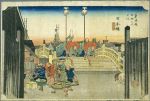
Hiroshige's woodblock print of Nihonbashi from his "Fifty-Three Stations of the Tokaido Road" series.
|
|
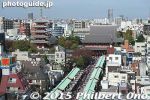
Green roofed Nakamise path to Sensoji temple in Asakusa.
|
|

Men managing the logs in the river eventually developed their own log tricks while on the job.
|
|

1. Fuji Murasaki (Purple Wisteria)
|
|
|

Pouring sweet tea over the BuddhaWhen the Buddha was born in Lumbini Garden in Nepal, sweet rain is said to have fallen. Thus, sweet tea is poured over the baby Buddha statue in the Hanamatsuri altar.
|
|

Second torii
|
|

"Heian" comes from "Heian-kyo," the former name of Kyoto city.
|
|

Hozu Gorge
|
|
|
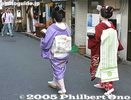
A geisha/geiko and maiko head to the theater to see the Kamogawa Odori. Notice the different obi sash on the back.A maiko is an apprentice geisha. Her obi sah on the back is long, as well as her sleeves.
|
|
|
|
|
|
|

Otemon Gate, Main gate to castle. Reconstructed in 1937. 大手門
|
|

Castle moat
|
|

Tonan-sumi (Southeast corner) Turret 東南隅櫓
|
|

Priests appear
|
|

Tommy Lasorda after throwing the flubbed first pitch.He just threw the ball right on the ground like he wanted to throw it away. It wasn't a pitch at all. What was his problem?
|
|
|

PIE 2006 ticket booth
|
|

Character balloons
|
|

Plum trees line the streets
|
|

Sidewalk
|
|

The men look more like the "fools."
|
|

Low branches are common
|
|

Musashimaru greets the crowd
|
|

Jisho-in Mausoleum
|
|
|

Shimada hairstyleStandard hairstyle for geisha. This a wig.
|
|

Former yokozuna Taiho, Takanosato, Kotozakura, and Wakanohana watch intently.
|
|

Festival participantsThey are dressed in the costume of the ancient Kofun (Tumuli) Period of Japan. They will be carrying torches from the nearby tumuli.
|
|
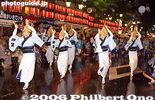
The parade route centers on JR Koenji Station. There are wide and narrow portions of the route.If it rains, they may stop the festival early.
|
|

Tekomai geisha costume is partially masculine with trousers instead of skirts. Their right shoulder is "exposed" showing a flower design. They carry a red paper lantern imprinted with their names and use their right hand to drag a wand."Asakusa" is written on her lantern. 手古舞
|
|

Eisen's woodblock print of Nihonbashi from his Kisokaido series.
|
|
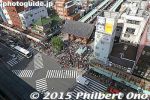
Kaminarimon Gate (big red lantern) and intersection in Asakusa.
|
|

A long bamboo pole is used for balance.
|
|
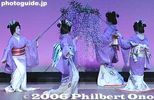
1. Fuji Murasaki (Purple Wisteria) by Kagurazaka geisha
|
|
|
|

Hanamatsuri celebrates the Buddha's birthday on April 8. This is Tsukiji Honganji in Tokyo.The flowers symbolize Lumbini Garden where the Buddha was born in present-day Nepal.
|
|

You wash your mouth hands here. Built in 1940 by Japanese living in the US. 大手水舎
|
|

The Heian Period was when Kyoto was the capital of Japan where the Emperor resided.
|
|
|
|

Entrance to Omoto-kyo HQ and former castle grounds
|
|

Pontocho Kaburenjo theater
|
|
|
|
|

Finish line 300 meters later
|
|

Final gate to Castle tower
|
|

World Heritage Site marker. 世界遺産 姫路城
|
|

Twin turrets of Akashi Castle
|
|

Tonan-sumi (Southeast corner) Turret 東南隅櫓
|
|

Way to Kokugikan. The guarded side gate on the right is for sumo wrestlers.
|
|
|

Crowd behind homeplate. 16,000 yen seats.
|
|
|

Ticket booth
|
|

Pretty CureKids could have their picture taken with these characters.
|
|

Yoshino Baigo's main attraction is the Ume no Koen plum park. This is an entrance leading to the park.
|
|

Monorail
|
|
|

Mansion of Mitsui Hachiroemon, one of the museum's must-see buildingsFounder of the Mitsui zaibatsu.
|
|

Hawaii's last sumo wrestler shakes hands.If he were married, his wife would be beside him.
|
|
|

Music and singing accompanimentAll numbers was accompanied by live music and singing.
|
|

Asashoryu greets the council upon entry
|
|

TumulusCherry trees are at the top.
|
|

Tekomai geisha
|
|
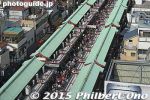
Nakamise
|
|
|

1. Fuji Murasaki (Purple Wisteria)
|
|
|

Baby Buddha statueLadles are provided for pouring the sweet tea over the Buddha. Sweet tea is also provided to worshippers. It symbolizes the sweet rain that fell when the Buddha was born.
|
|

Gate built in 1934. 神門
|
|
| 26737 files on 107 page(s) |
1 |
 |
 |
 |
 |
|